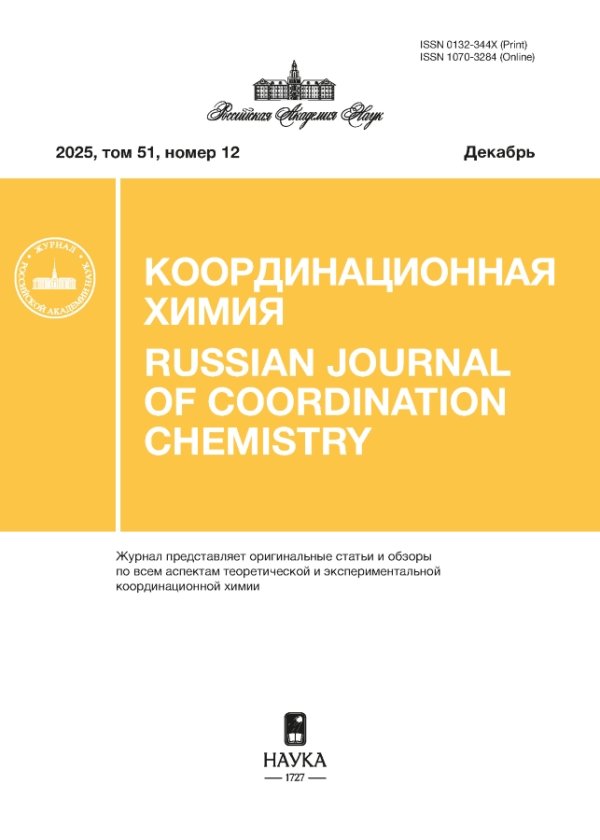Vol 51, No 12 (2025)
Articles
OPTOELECTRONIC AND REDOX PROPERTIES OF NEW DIETHYL-SUBSTITUTED TIN(IV) COMPLEXES WITH SCHIFF BASES CONTAINING A HYDRAZONE FRAGMENT
Abstract
New mononuclear tin(IV) complexes were obtained by condensation of diethyltin oxide Et2SnO with a series of Schiff bases containing a hydrazone fragment. The structure of the complexes was confirmed by 1H, 13C, and 119Sn NMR spectroscopy and X-ray diffraction analysis (CCDC 2451176 (2), 2451177 (3), and 2451178 (4)). Optoelectronic and redox properties of complexes 1–4 were studied using UV spectroscopy and cyclic voltammetry, and the energy gap value was estimated. Electrochemical oxidation and reduction of complexes 1, 2, and 3 are irreversible and are accompanied by further chemical transformations. In contrast, electroreduction of complex 4 with a pincer ligand results in the formation of persistent anion–radical particles.
 745–762
745–762


THERMODYNAMIC AND KINETIC FACTORS OF THE STRUCTURE FORMATION OF BIS-CHELATE COMPLEXES OF NI(II) WITH O-HYDROXY- AND O-MERCAPTOAZOBENZAMIDES: A QUANTUM CHEMICAL STUDY
Abstract
The molecular structures and relative energies of the low-spin bis-chelate Ni(II) complexes with o-hydroxy- and o-mercaptoazobenzene ligands were calculated using density functional theory, taking into account the possibility of forming trans- and cis-isomeric structures with six- and five-membered metallacycles. The kinetic factor governing the structure formation of NiL2 complexes was analyzed using a stepwise model of their formation (Ni2+ + (L)– → (NiL)+, (NiL)+ + (L)– → NiL2). The results show that the most favorable isomer of the complexes is determined not only by the energy advantage of a particular configuration, but also by its kinetic accessibility, which is governed by the activation barriers of the isomerization reactions of the products formed at the first step of the interaction of the initial reagents.
 763–773
763–773


LITHIUM DERIVATIVES OF 5-METHYL-5,10-DIHYDROINDENO[1,2-b] INDOLE AND 1,3,5-TRIMETHYL-6H- DIHYDROINDENO[2,1-b] INDOLE. SYNTHESIS AND MOLECULAR STRUCTURE
Abstract
The reaction of 1,3-dimethyl-5,6-dihydroindeno[2,1-b]indole with methyl iodide in the presence of cetyltrimethylammonium bromide yielded 1,3,5-trimethyl-6H-indeno[2,1-b]indole (L1H). The molecular structure of the compound was confirmed by X-ray diffraction. 1,3,5-Trimethyl-6H-indeno[2,1-b]indole (L1H) and 5-methyl-5,10-indeno[1,2-b]indole (L2H) are metallated with n-butyl lithium in diethyl ether at 0°C to form the corresponding lithium derivatives L1Li(Et2O)2 (1) and L2Li(Et2O)2 (2). According to X-ray diffraction data, lithium complex 2 has a monomeric structure, with two crystallographically independent molecules of the complex located in the independent region of the crystal cell. In molecule 2b, the lithium cation is coordinated by the five-membered ligand cycle by the η5-type, and in molecule 2a, by the η3-type.
 774–782
774–782


METAL-ORGANIC FRAMEWORK [CD2(Bdc),Dabco]: SYNTHESIS, CRYSTAL STRUCTURE, AND PHOTOLUMINESCENCE PROPERTIES
Abstract
A new coordination polymer [Cd2(Bdc),Dabco] (I) was obtained by the reaction of cadmium nitrate, terephthalic acid (Bdc), and 1,4-diazabicyclo[2.2.2]octane (Dabco) in N,N-dimethylformamide. Its structure was determined by X-ray diffraction (CCDC No. 2441975). This MOF exhibits high thermal stability, with rapid mass loss beginning at temperatures above 420°C. Compound I demonstrates photoluminescence at 430 nm (λex = 380 nm) with lifetimes of 5 and 12 ns and a quantum yield of 6%.
 783–791
783–791


SEARCH FOR COMBINATIONS OF MONOCARBOXYLIC ACIDS TO OBTAIN MIXED-ANION COMPLEXES OF CADMIUM AND ZINC
Abstract
The possibility of obtaining mixed-anion complexes of cadmium and zinc with various combinations of monocarboxylic acid anions was investigated. The combination of pentafluorobenzoate (Pfb), benzoate (Bz) anions, with 1,10-phenanthroline (Phen) within a single compound leads to the formation of crystals of previously reported homoanionic complexes. When using 2,3,5,6-tetrafluoro-4-(trifluoromethyl)phenylacetate (Tfpha) or 3,5-dinitrobenzoate (Dnb) anions instead of pentafluorobenzoate, it was possible to isolate mixed-anion compounds [Cd2(Phen)2(Tfpha)2(Bz)2] (I), [Cd3(Phen)2(Dnb)3(Bz)3][Cd3(Phen)2(Dnb)4.5(Bz)1.5] (II), [Zn3(Phen)2(Dnb)4(Bz)2] · 2(C6H6) (III), [ZnCd2(Phen)2(Dnb)5(Bz)] · 3 (C6H6) · (MeOH) (IV). In the structure of compounds II and IV, according to X-ray diffraction data, in some anion sites the Bz-and Dnb-anions are refined simultaneously with different occupancies. Using the compounds [Cd2(Phen)2-(Dnb)2(Pha)2] (V) and [Zn(H2O)(Phen)(Dnb)(Pha)]·MeCN (VI, Pha – phenylacetate anion) as examples, it is shown that mixed-anion complexes can also be formed when a conformationally flexible phenylacetate anion is combined with a stereochemically more rigid 3,5-dinitrobenzoate anion at zinc and cadmium centers. The synthesized compounds were characterized by X-ray diffraction analysis (CCDC nos. 2443227, 2443228, 2443229, 2443230, 2443231, and 2443232, respectively), IR spectroscopy, and CHN analysis. It has been found that the main contribution to the stabilization of the crystal packings is provided by π···π, C–H···F, N–O···π, and NO2···NO2.
 792–808
792–808


ANALYSIS OF THE SPIN STATE OF THE IRON COMPLEXES WITH HYDROXYSUBSTITUTED 2,6-BIS(PYRAZOL-3-YL)PYRIDINES FOR DEPROTONATION IN SOLUTION
Abstract
Simple mixing of iron(II) perchlorate hexahydrate with the corresponding 2,6-bis(pyrazol-3-yl) pyridine bearing either a phenyl (LH) or ortho-difluorophenyl (LF) group at the 1-position of the pyrazolyl moiety and a deprotonatable hydroxyl group at its 5-position in deuterated methanol within an NMR tube yielded the previously described iron(II) complexes [Fe(LH)2](ClO4)2 and [Fe(LF)2](ClO4)2. Analysis of the temperature dependence of their 1H NMR chemical shifts confirmed that both complexes remain in a high-spin state. Using the same approach, the possibility of in situ reversible deprotonation of the pH-sensitive hydroxyl groups in their ligands under the action of 1,8-diazabicyclo[5.4.0]undec-7-ene (DBU) was demonstrated, and the potential for shifting the spin equilibrium via deprotonation was investigated.
 809–819
809–819












